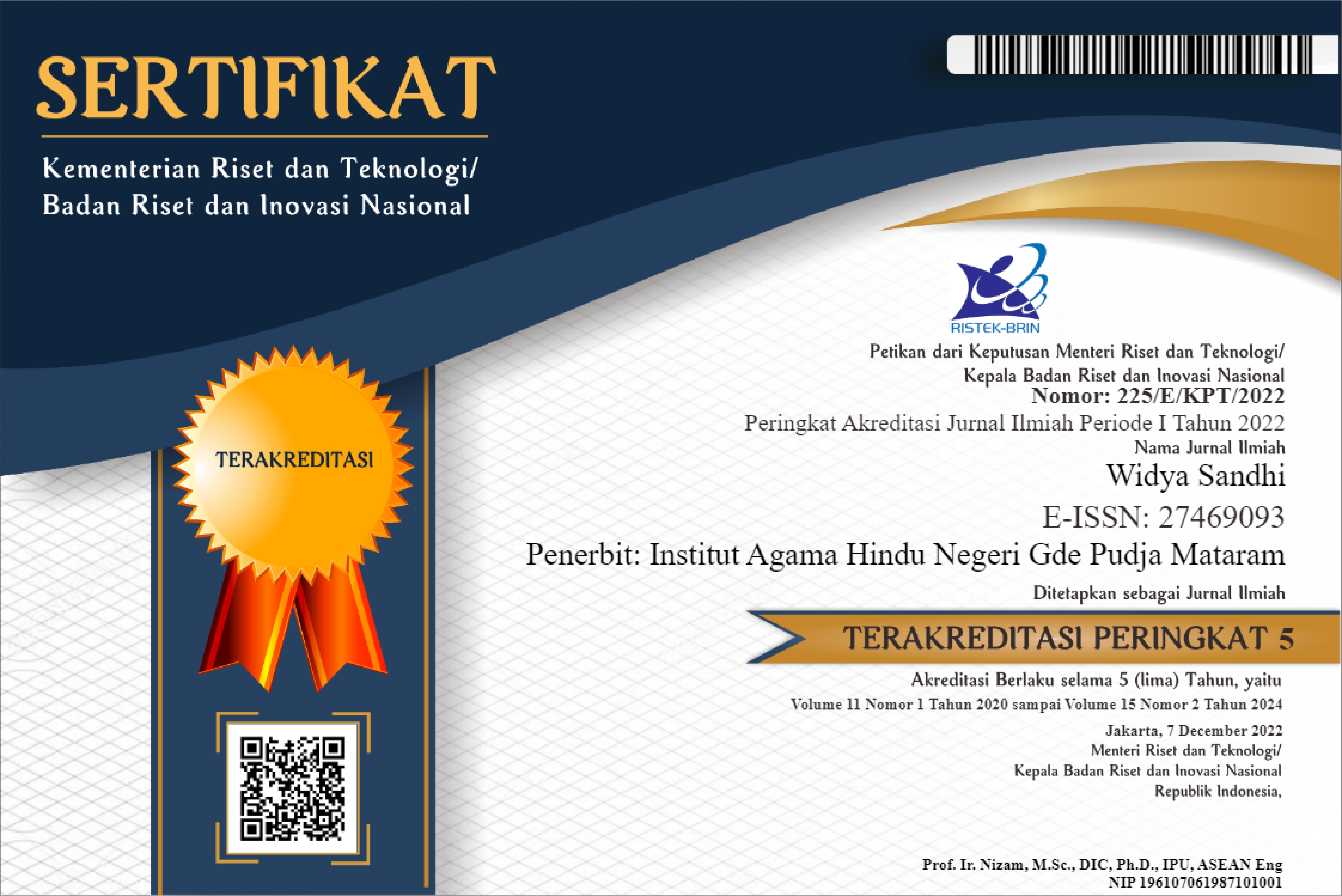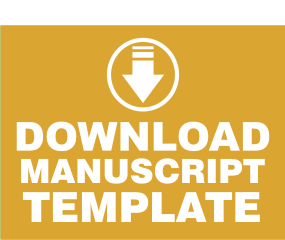Tutur Wiksu Pungu: Analisis Semiotik
Abstract
Understanding the teachings of Tutur Wikṣu Pungu in symbolic form is needed to conduct an in-depth study to reveal its meaning. This research aims to examine the symbolic meaning in the text so that it can contribute to Hindus as a whole. This qualitative research uses an interpretative descriptive approach based on Riffaterre's semiotic theory, focusing on symbolic elements. The research method used includes heuristic and hermeneutic reading techniques to explore the deep meaning of the symbols in the text. There are three main discussions in this research. First, the identification of the matrix (main idea) emphasises the importance of asceticism, self-control, and yoga-samadhi as a path to cosmic harmony between humans, nature, and God. Second, the model (symbolic elements), including the symbols of tri bhuvana (three worlds), pa ca mah? bh?ta (five elements of nature), Sang Hyang Aji as sacred knowledge, and guru as spiritual guide. The third variant (philosophical meaning) examines the philosophical meaning of the symbols. This research contributes to the study of Hindu theology by revealing how the teachings in Tutur Wikṣu Pungu can be relevant to religious life in the modern era.
References
Barthes, R. (1967). Elements of Semiology. Hill and Wang.
Capra, F. (2015). THE TAO OF PHYSICS.
Eliade, M. (1975). THE SACRED AND THE PROFANE: The nature of religion. Harcourt Brace Jovanovich.
Geertz, C. (2019). The Religion Of Java. In Sustainability (Switzerland) (Vol. 11, Issue 1). The University of Chicago Press. http://scioteca.caf.com/bitstream/handle/123456789/1091/RED2017-Eng-8ene.pdf?sequence=12&isAllowed=y%0Ahttp://dx.doi.org/10.1016/j.regsciurbeco.2008.06.005%0Ahttps://www.researchgate.net/publication/305320484_SISTEM_PEMBETUNGAN_TERPUSAT_STRATEGI_MELESTARI
Maulana, L. (2019). Herustik, Hermeneutik Semiotika Michael Riffaterre. Qof, 3(1), 67–78. https://doi.org/10.30762/qof.v3i1.1055
Mayuni, A. A. I., Yasa, I. W. S., & Utama, I. W. B. (2020). Wacana Eskatologis Dalam Putru Pasaji. Dharmasmrti: Jurnal Ilmu Agama Dan Kebudayaan, 20(1), 10–18. https://doi.org/10.32795/ds.v20i1.636
Palguna, I. D. (2000). Cara Mpu Monaguna Memuja Siwa (Catatan Dari Kakawin Sumanasantaka. Yayasan Dharmasastra.
Penyusun, T. (2015). Salinan Lontar Wiksu Pungu Sundari dan Swamandala. STAHN Gde Pudja Mataram.
Premananda, R. . (2024). Implementasi Ajaran Kalepasan dalam Lontar Tutur Wikṣu Pungu di Kecamatan Denpasar Timur. STAHN Mpu Kuturan Singaraja.
Satriya Wibawa, I., Wijana, I., & Sukartha, I. (2017). Teks Pragusa Parwa: Analisis Struktur Dan Semiotik. Humanis, 18(1), 120–126.
Sharma, R. (2023). Reinterpreting classical Hindu texts in modern times: A critical study. Oxford University Press.
Soebadio, H. (1985). Jnanasiddhanta. Djambatan.
Suarka, I. N. (2012). Telaah Sastra Kakawin Sebuah Pengantar. Pustaka Larasan.
Tri Dayati. (2014). Analisis Semiotik Tembang Macapat Pupuh Asmaradana dalam Serat Witaradya 2 Karya Raden Ngabehi Ranggawarsita. Jurnal Program Studi Pendidikan Bahasa Dan Sastra Jawa_Universitas Muhammadiyah Purworejo, 05(05), 22–30.
Triguna, I. B. G. Y. (2000). Teori Tentang Simbol. Widya Dharma.
Windya, I. M. (2021). Brahmawidyā Dalam Tattwa Sanghyang Mahājñāna. Kamaya: Jurnal Ilmu Agama, 4(3), 321–333. https://doi.org/10.37329/kamaya.v4i3.1365
Wiyasa, I. P., Bawa, A. A. G., & Suarka, I. N. (2017). Kakawin Dharma Sawita: Analisis Semiotik. Jurnal Humanis Fakultas Ilmu Budaya Unud, 18, 226–233.

This work is licensed under a Creative Commons Attribution-NonCommercial-ShareAlike 4.0 International License.
Authors who publish with this journal agree to the following terms:
- Authors retain copyright and grant the journal right of first publication with the work simultaneously licensed under a Creative Commons Attribution-ShareAlike 4.0 International License. that allows others to share the work with an acknowledgment of the work's authorship and initial publication in this journal.
- Authors are able to enter into separate, additional contractual arrangements for the non-exclusive distribution of the journal's published version of the work (e.g., post it to an institutional repository or publish it in a book), with an acknowledgment of its initial publication in this journal.
- Authors are permitted and encouraged to post their work online (e.g., in institutional repositories or on their website) prior to and during the submission process, as it can lead to productive exchanges, as well as earlier and greater citation of published work (See The Effect of Open Access).






.jpg)




